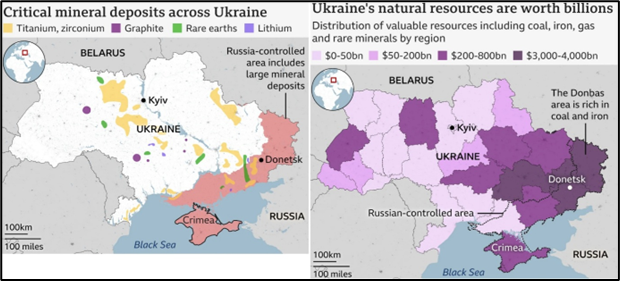Why in News?
The US and Ukraine have finalized a major minerals deal after months of tense negotiations, including a heated Oval Office meeting between Presidents Trump and Zelenskyy.
Under the agreement, the US gains preferential access to Ukrainian mineral and resource licenses, while Ukraine receives financial and military aid for post-war reconstruction.
Trump called the deal "payback" for the $350 billion he claims the US has spent supporting Ukraine, though official figures show $182.8 billion.
What’s in Today’s Article?
- Ukraine’s Strategic Mineral Wealth
- Key Highlights of the US–Ukraine Minerals Deal
- US-Ukraine Minerals Deal and Security Guarantees
Ukraine’s Strategic Mineral Wealth

- Ukraine holds approximately 5% of the world’s critical raw materials, giving it a strategic edge in the global supply of essential minerals.
- Ukraine has deposits of 22 out of the 34 minerals identified as critical by the European Union.
- These include: Industrial and construction materials; Ferro alloys and non-ferrous metals; Precious metals and rare earth elements.
- Key Mineral Reserves
- Graphite: 19 million tonnes of proven reserves; among the top five global suppliers. Crucial for EV batteries.
- Titanium: Holds 7% of Europe's supply; used in aerospace and infrastructure.
- Lithium: Contains one-third of Europe’s deposits; essential for modern batteries.
- Other Crucial Elements: Includes beryllium and uranium, important for nuclear technology.
- Additional Metals: Ukraine has significant reserves of copper, lead, zinc, silver, nickel, cobalt, and manganese.
- Rare Earth Elements: Hosts deposits of all 17 rare earths used in electronics, defense, and green energy.
- Geographic Distribution of Major Resources
- Titanium: Found mostly in northwestern and central Ukraine
- Lithium: Located in central, eastern, and southeastern regions
- Graphite: Found in central and western Ukraine; represents 20% of global reserves
- Coal: Reserves remain significant, though most are now in Russian-occupied territory
- Russian Occupation and Economic Loss
- An estimated $350 billion worth of mineral resources lie in territories occupied by Russia.
- As of 2022, Russia controls:
- 63% of Ukrainian coal mines
- 50% of manganese, caesium, tantalum, and rare earth deposits.
- Russia has seized at least two lithium sites:
- One in Donetsk
- One in Zaporizhzhia
- Ukraine still retains control of lithium reserves in the central Kyrovohrad region.
Key Highlights of the US–Ukraine Minerals Deal
- The agreement was signed by US Treasury Secretary Scott Bessent and Ukraine’s Vice Prime Minister Yulia Svyrydenko.
- Oil and gas included alongside minerals
- While the deal focuses on Ukraine's mineral wealth, it also covers oil, natural gas, and other hydrocarbons.
- In all cases, Ukraine retains full ownership of the resources, though the US will have joint access.
- United States–Ukraine Reinvestment Fund
- A new fund will be created and jointly managed by both countries on an equal partnership basis.
- For the first ten years, all profits and revenues from the fund are expected to be reinvested into Ukraine’s development.
- Resource Ownership and Control
- Ukraine will retain full ownership and control over its natural resources, with the right to decide where and what to extract.
- Contributions to the Fund
- The US will contribute via direct funding or new military assistance.
- Ukraine will contribute 50% of revenues from new licenses for critical materials, oil, and gas extraction.
- Use of Military Assistance
- The agreement emphasizes future military support—potentially including air defence systems—and confirms Ukraine will not owe any debt to the US for past aid.
US-Ukraine Minerals Deal and Security Guarantees
- No Formal Security Guarantees Included
- The minerals deal does not contain explicit security guarantees for Ukraine.
- President Zelenskyy has refused peace talks with Russia unless future security assurances are provided.
- Military Assistance Still Possible
- While not a guarantee, the deal revives the prospect of continued US military aid.
- Analysts view this as a strategic signal of US interest in Ukraine’s future.
- US Troop Involvement Ruled Out
- Trump has not committed to sending US troops or backing European military involvement in Ukraine.
- The deal is economic and strategic, not a defense pact.
- Potential Deterrence Against Russia
- According to analysts, the agreement creates US investment and strategic interest in Ukraine.
- This could deter future Russian aggression, as the US would likely respond with sanctions and military support.










